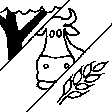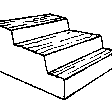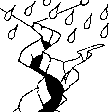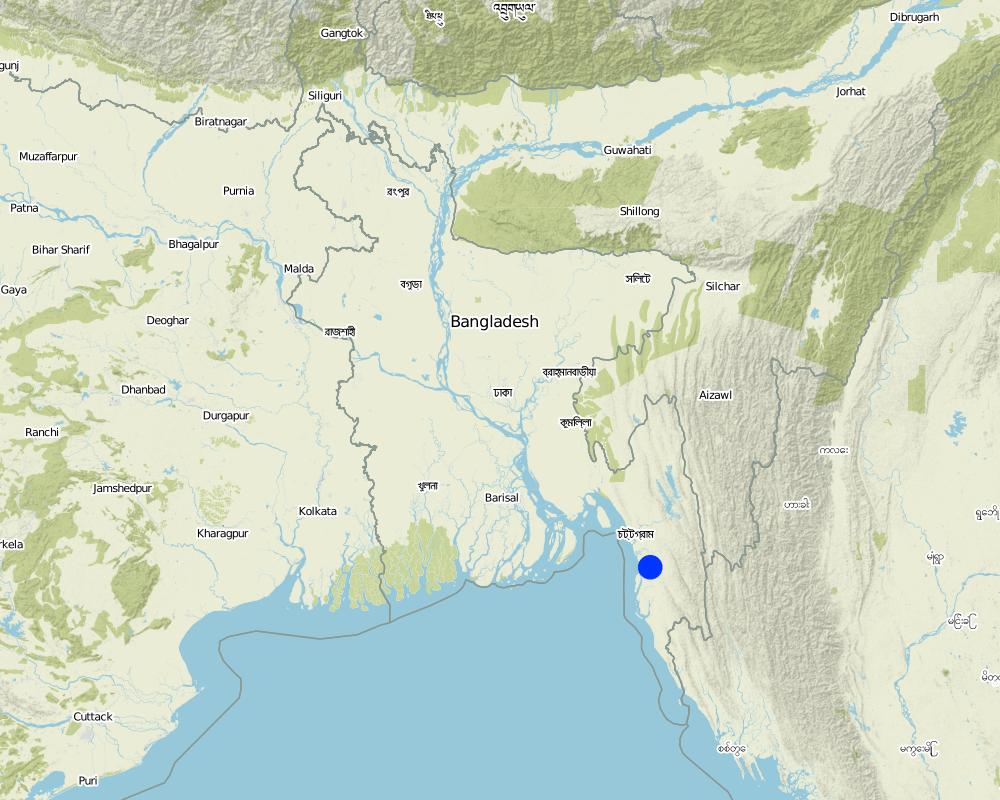Multipurpose Earthen Dam [Bangladesh]
- Creation:
- Update:
- Compiler: Sankar Paul
- Editor: –
- Reviewer: David Streiff
Goda
technologies_1344 - Bangladesh
View sections
Expand all Collapse all1. General information
1.2 Contact details of resource persons and institutions involved in the assessment and documentation of the Technology
Name of the institution(s) which facilitated the documentation/ evaluation of the Technology (if relevant)
Bangladesh Forest Research Institute (Bangladesh Forest Research Institute) - Bangladesh1.3 Conditions regarding the use of data documented through WOCAT
When were the data compiled (in the field)?
14/03/2004
The compiler and key resource person(s) accept the conditions regarding the use of data documented through WOCAT:
Yes
2. Description of the SLM Technology
2.1 Short description of the Technology
Definition of the Technology:
Artificial earthen dam constructed in the narrow valley of the hills for water harvesting, aquaculture, house hold uses and irrigation.
2.2 Detailed description of the Technology
Description:
The embankment is situated in the narrowest part of the valley using soil from nearby areas. Earthen dam constructed in the narrow valley of the hiills for water harvesting,aquaculture, house hold uses and irrigation of seasonal crops. Both sides of the embankment are protected by a bamboo mat. The usual length is 30 m, width 5 m and height 1.5 m. The bund is compacted manually, easy maintenance, enviornment firendly.
2.5 Country/ region/ locations where the Technology has been applied and which are covered by this assessment
Country:
Bangladesh
Region/ State/ Province:
Chittagong Hill Tracts
Map
×2.6 Date of implementation
If precise year is not known, indicate approximate date:
- more than 50 years ago (traditional)
2.7 Introduction of the Technology
Specify how the Technology was introduced:
- as part of a traditional system (> 50 years)
Comments (type of project, etc.):
From the past generations
3. Classification of the SLM Technology
3.1 Main purpose(s) of the Technology
- access to water
3.2 Current land use type(s) where the Technology is applied

Mixed (crops/ grazing/ trees), incl. agroforestry
Comments:
Major land use problems (compiler’s opinion): Most land are sloping, medium fertility, poor vegetative cover in the catchments, lack of improved technology, poor economy
Major land use problems (land users’ perception): Small amount of flat land, soil fertility degradation, lack of capital, difficult to work in the slopy area.
3.3 Further information about land use
Number of growing seasons per year:
- 2
3.4 SLM group to which the Technology belongs
- water harvesting
- irrigation management (incl. water supply, drainage)
3.5 Spread of the Technology
Specify the spread of the Technology:
- applied at specific points/ concentrated on a small area
Comments:
Total area covered by the SLM Technology is 0.004 km2.
New area interms of settlement under cooperative management system
3.6 SLM measures comprising the Technology

structural measures
- S5: Dams, pans, ponds
3.7 Main types of land degradation addressed by the Technology

soil erosion by water
- Wt: loss of topsoil/ surface erosion
Comments:
Main type of degradation addressed: Wt: loss of topsoil / surface erosion
4. Technical specifications, implementation activities, inputs, and costs
4.2 Technical specifications/ explanations of technical drawing
Technical knowledge required for field staff / advisors: moderate
Main technical functions: control of dispersed runoff: retain / trap
Construction material (earth): Accumulation of soil to retain water.
Construction material (wood): reinforcement of bund and to protect slumping down.
For water harvesting: the ratio between the area where the harvested water is applied and the total area from which water is collected is: 1:200.00
Layout change according to natural and human environment: depending on valley width, depth and amount of water will be researved
4.3 General information regarding the calculation of inputs and costs
other/ national currency (specify):
Taka
Indicate exchange rate from USD to local currency (if relevant): 1 USD =:
60.0
Indicate average wage cost of hired labour per day:
1.20
4.4 Establishment activities
| Activity | Type of measure | Timing | |
|---|---|---|---|
| 1. | Bamboo structure preparation and earth working | Structural | 2 days |
| 2. | earth work | Structural | 5 days |
| 3. | Prepare out-let | Structural | 1 |
| 4. | Compacting bund | Structural | 2 |
| 5. | wooden poles piling , setting bamboo mat and soil dumping | Management | 2-4 days |
4.5 Costs and inputs needed for establishment
Comments:
Duration of establishment phase: 12 month(s)
4.6 Maintenance/ recurrent activities
| Activity | Type of measure | Timing/ frequency | |
|---|---|---|---|
| 1. | Filling-up depressions formed during previous rainy season | Structural | 2 days/annual |
| 2. | Reparing bamboo mat | Structural | 2/annual |
| 3. | filling up with soils, protecting water likage,repairing bamboo mats etc. | Management | 1-2 days / 1-2 times in a year |
4.7 Costs and inputs needed for maintenance/ recurrent activities (per year)
Comments:
Bands structure with length,width & height
4.8 Most important factors affecting the costs
Describe the most determinate factors affecting the costs:
Dam construction and maintenance
5. Natural and human environment
5.1 Climate
Annual rainfall
- < 250 mm
- 251-500 mm
- 501-750 mm
- 751-1,000 mm
- 1,001-1,500 mm
- 1,501-2,000 mm
- 2,001-3,000 mm
- 3,001-4,000 mm
- > 4,000 mm
Specifications/ comments on rainfall:
Seldom goes more than 3000
Agro-climatic zone
- humid
Prevail monsoon climate
5.2 Topography
Slopes on average:
- flat (0-2%)
- gentle (3-5%)
- moderate (6-10%)
- rolling (11-15%)
- hilly (16-30%)
- steep (31-60%)
- very steep (>60%)
Landforms:
- plateau/plains
- ridges
- mountain slopes
- hill slopes
- footslopes
- valley floors
Altitudinal zone:
- 0-100 m a.s.l.
- 101-500 m a.s.l.
- 501-1,000 m a.s.l.
- 1,001-1,500 m a.s.l.
- 1,501-2,000 m a.s.l.
- 2,001-2,500 m a.s.l.
- 2,501-3,000 m a.s.l.
- 3,001-4,000 m a.s.l.
- > 4,000 m a.s.l.
Comments and further specifications on topography:
Slopes on average: Narrow valley are generally with less slope gradient.Hilly slopes surrounding the reservoir
Landforms: Slopes are varaible and valleys are mostly V-shaped and narrow
5.3 Soils
Soil depth on average:
- very shallow (0-20 cm)
- shallow (21-50 cm)
- moderately deep (51-80 cm)
- deep (81-120 cm)
- very deep (> 120 cm)
Soil texture (topsoil):
- medium (loamy, silty)
- fine/ heavy (clay)
Topsoil organic matter:
- medium (1-3%)
If available, attach full soil description or specify the available information, e.g. soil type, soil PH/ acidity, Cation Exchange Capacity, nitrogen, salinity etc.
Soil texture (topsoil): Depends on the the soils of the catchments but fine soils are commonly washed out from upper catchments.
Soil fertility is medium and depends on the the soils of the catchments
Topsoil organic matter: High rainfall washes out top soil under thinly covered soil
Soil drainage / infiltration is poor in the valleys
Soil water storage capacity is high in finer soils and around the dam and medium if the soil are coarse
5.6 Characteristics of land users applying the Technology
Off-farm income:
- less than 10% of all income
Relative level of wealth:
- average
Indicate other relevant characteristics of the land users:
Population density: 10-50 persons/km2
Annual population growth: 2% - 3%
30% of the land users are average wealthy and own 4% of the land (own minimum 5 acre of land).
5.8 Land ownership, land use rights, and water use rights
Land ownership:
- individual, titled
Land use rights:
- individual
6. Impacts and concluding statements
6.4 Cost-benefit analysis
How do the benefits compare with the establishment costs (from land users’ perspective)?
Short-term returns:
slightly positive
Long-term returns:
positive
How do the benefits compare with the maintenance/ recurrent costs (from land users' perspective)?
Short-term returns:
slightly positive
Long-term returns:
positive
6.5 Adoption of the Technology
- 1-10%
If available, quantify (no. of households and/ or area covered):
5 households covering 10 percent of stated area
Of all those who have adopted the Technology, how many have did so spontaneously, i.e. without receiving any material incentives/ payments?
- 90-100%
Comments:
5 land user families have adopted the Technology without any external material support
Comments on spontaneous adoption: survey results
There is a strong trend towards spontaneous adoption of the Technology
Comments on adoption trend: Due to higher benefits shown by the technolgy in the farmering site
Links and modules
Expand all Collapse allLinks
No links
Modules
No modules


